The Brethern
Think of the Brethern in Maddiston and one name springs to mind, James Black. Jimmy, who hailed from Airdrie, came to Maddiston to work at Manualrigg Coillery as an office boy, then became a miner there until its closure in the nineteen twenties, he then became the Absentee Officer for Muiravonside School Board.
Jimmy preached the gospel for so many years in the hall down the Coal Road that the hall became known as "Jimmy Blacks' Hall", Jimmy was also a tireless worker on behalf of Polmont Borstal and received the British Empire Medal for his services to that place.Davie Anderson was the Sunday school superintendent. meetings were also held throughout the villages, many remember the men in black suits, bowler hats, and umbrellas (God's work won't wait for the sun to shine).
The Faith Mission
Fred Dougall began the faith mission at the corner of Greenhithe and Carron Terrace; Fred was a lay preacher (originally a Methodist). Pilgrims from Ireland came over to help Fred in his mission; they set up a marquee at the putting green in Brightons (where Dr. Erskines’ house was built - the corner of Main St. and Station Rd.) They went round the villages playing concertinas, singing, and inviting people to their open-air conventicles.Fred Dougal and John Anderson preached here every Sunday. The Sunday school was run by Brightons Church; Mr. Raeside who was the Headmaster of Redding School oversaw the Sunday school. Pilgrims, mostly from Ireland came here; they were mostly female and wore felt hats of the type seen in medieval paintings.
Evangelical
Dennis Barnes came to the village periodically and pitched his marquee at the I.L.P. hall, he and his wife, Hetty Baxter, travelled the country in a caravan. Denis was born in Dumfriesshire and became a boxer, amateur then professional, moved to Birmingham, started up boys’ clubs and then seems to have travelled round preaching the word of God to the general populace
Religion
Muiravonside parish, like many others, had a diverse range of faiths within its boundaries. This reflects the rich cultural and religious tapestry of the community, with people of different beliefs coexisting and contributing to the vibrant social fabric of the area. The presence of multiple faiths also serves as a reminder of the importance of tolerance and understanding in a multi-faith society, where individuals are free to practice their own beliefs while respecting those of others. The diversity of faiths in Muiravonside parish undoubtedly adds to the unique character and inclusive nature of the community, fostering a sense of unity and cooperation among its residents.
Church of Scotland
Maddiston (along with the rest of the parish of Muiravonside) was originally in the Parish of Falkirk although according to a Papal mandate dated 1454 "the chapel at this place (Manuell) has from time immemorial had cemetery, baptistry, chrism vase, burial place and priest ". The mandate gave the people of the district the right to elect a clerk-minister to assist the priest, but whether he was assisting the priest at the chapel in the castle of Haining or at the nunnery at Manuell is not clear.
The Nunnery at Manuell (The church of the Cistercian Nunnery of Emanuell) was founded by David 1 (1124-53) but the name seems to point to an earlier foundation.
The last prioress was Jean Livingston, around 1560, the most part of the building and the cemetery was washed away in a flood in 1783.
The original parish church of Muiravonside was founded in 1648 and the present church seems to be built on the site of the former, the Old Statistical Account describes as "old" a church building standing in the old kirkyard. No ruins or foundations of a former church have been found anywhere in the Parish. The belfry and bell (with the inscription "For the Kirk of Muiravonside John Meikle Me Fecit / Edinburgh 1699) on the present church (built in 1806) predate it and almost certainly belong to the earlier one.
In 1947, it was found that wood-worm and dry-rot had so badly infested the building that com[lete internal restoration was necessary.A new vestibule was added at the east end of the vestry and session house, the old session house which stood at the gateway to the church being demolished. A carved stone cross, again of earlier origin than the session house which it surmounted was places above the east wing of the church.
In 1980, the Double manual Trayser Harmonium, gifted by Mrs. Brown of Vellore was replaces by an Omegan electronic organ.
The church is almost barn like in construction and before being refurbished in 1955 the pulpit was situated in the centre of the South side wall, with the pews on three sides and a semi-circular gallery on the East-North and West side.
Now the church has an aisle running East West with the pulpit and chancel placed at the West end gable which also houses a decorative window giving the date of renovation.
A most attractive feature of the church is the stained glass windows commemorating the ministry of the Rev. George Keith, M.A.,B.D. 1871-1884.
After the building of Cairneymount the morning service was held here, Sandy Spence calling the faithful to worship every Sunday morning at 11 by ringing that bell which had been calling their forebears since 1699.
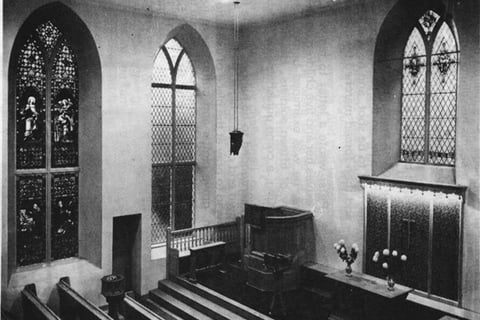

The interior after restorations in 1955
The Ministry
CHURCH REGISTER
Unknown.................................................................................................................1648-1690
Rev. Donald Campbell, M.A......................................................................................1691-1695
Rev.Andrew Bennett.................................................................................... ............1696-1720
Rev. Robert Boyd M.A..................................................................................... .........1721-1767
Rev. John Bertram.....................................................................................................1768-1802
Rev. William McCall..................................................................................... ............1803-1833
Rev. James McFarlan.................................................................................................1834-1870
Rev. George Keith, M.A.,B.D.....................................................................................1871-1884
Rev. Oswald Bell........................................................................................................1885-1896
Rev.David Bayne, B.D................................................................................................1897-1940
Rev. James Hamilton.................................................................................................1940-1952
Rev.James C. Downie, M.A.,B.D........................ .......................................................1952-1966
Rev. Duncan G. McPherson.......................................................................................1967-1975
Rev. Richard A. Goodman..............
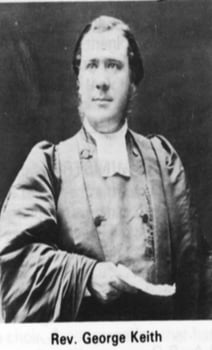

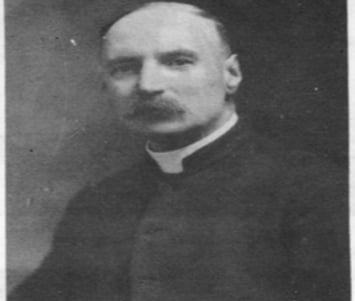

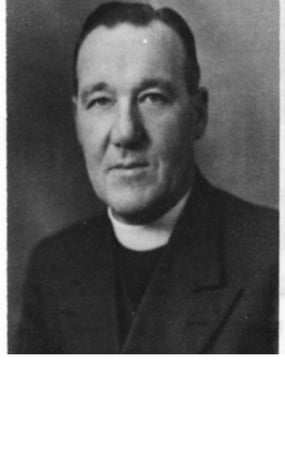

Rev. James Hamilton
Rev. David Bayne
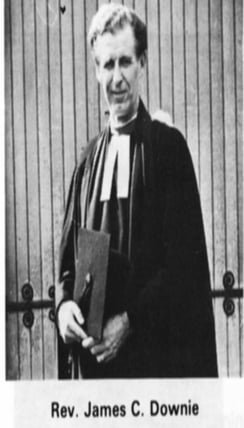

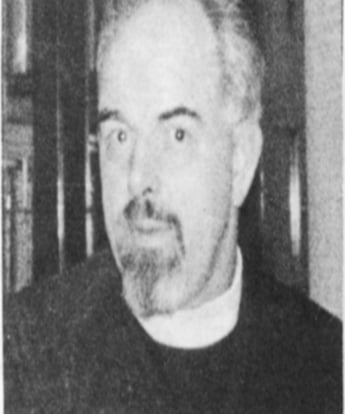


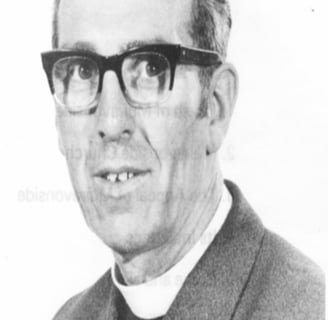
Rev. Duncan g McPheson
Rev. Richard A Goodman
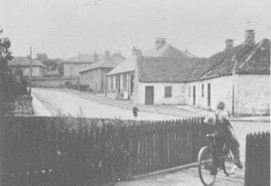

Roman Catholic
The chapel was opened in 1891 by the Archbishop of St Andrews and Edinburgh, it remained unchanged till after the 1914-18 war when the bell tower was added in memory of those who died.
The report from the " Falkirk Herald" ran thus.
"[ at Rumford]. Early on Sunday morning Canon Grady, accompanied by the full choir of the Falkirk Chapel, went to Rumford where the Rev. Canon duly blessed the new building according to the rites of the church. Archbishop Smith thereafter preached the initial sermon from the text John iv, 24, upon which his Lordship preached a very eloquent sermon. The Sacrament of Mass was sung by Canon Grady and choir.
Mr. MacDonald, conductor of the Carron Band, led the music, which included the Winter Mass and Novellos' arrangement of the " Adestes Fideles ". At the harmonium Miss O'Conner presided, and solos were sung by Miss Flanagan and Miss Bridget Owen, Miss Mary Owens, and others. The building thus dedicated is an oblong structure some sixty-two feet by thirty feet. Its design is unique, being the original design of Canon Grady. The Rev. Canon stated concerning the state of his faith, that whereas the Reverent Paul MacLachlan 45 years ago held the ministry of nearly all of Stirlingshire and part of Linlithgow, there are to-day 16 priests engaged in the same work."
The chapel bells rang out over the villages every day at 7.30, 12 noon and 6 p.m., mass was at 9 a.m. every morning (and two masses on Sunday) then on Sunday and Thursday night there was Benediction.
A service bus ran every Sunday for the catholic communities of Whitecross, Standburn, Avonbridge, Blackbraes, California, Sheildhill, in fact all the surrounding area who worshipped at Rumford.
The Chapel also served the community as a school (not for just the Catholic children) one report cites 44 pupils attending; the last known pupil was Peter Forgie.
Rumford Chapel now serves a very different purpose, that of a plumber’s business....
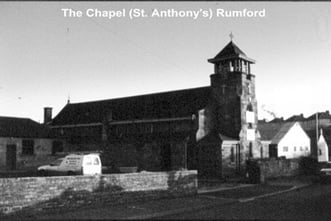

Salvation Army
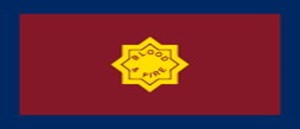

The Salvation Army flag - an emblem of faith
Through the explanation of the colours and the writing, the flag of the Salvation Army becomes actually a symbol of the faith of each Salvationist. The blood of the Lord Jesus Christ (red), which cleanses and delivers from our guilt and the Spirit of God (yellow) who leads and guides, and finally the blue border as symbol of purity. Salvation and sanctification are expressed through the words "Blood and Fire".
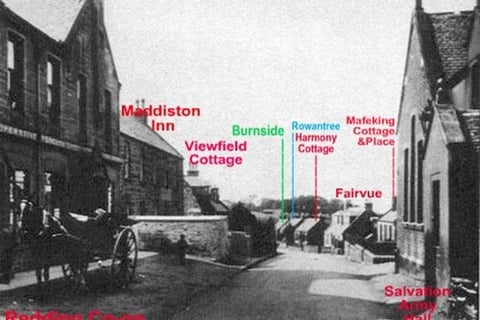

The hall (seen on the above photo on the right) was opened in 1877 as a "British Workmens' Public House", it was designed as a restaurant with a library and reading room, it later became known as the "coffee house", it seems that this was mainly financed by Mr. Livingstone Learmonth of Parkhall.
In 1882 the hall was gifted by Mr. Learmonth to The Salvation Army on condition it was used for worship.
Public House", it was designed as a restaurant with a library and reading room, it later became known as the "coffee house", it seems that this was mainly financed by Mr. Livingstone Learmonth of Parkhall.
In 1882 the hall was gifted by Mr. Learmonth to The Salvation Army on condition it was used for worship.
The connection The hall (seen in the above photo on the right) was opened in 1877 as a "British Workmens' between Maddiston and The Salvation Army can be traced to when Mr. Learmonth heard the army mother, Catherine Booth, preach in Seymour Hall West London and went back to his town house in Gloucester Gardens and told his wife she must hear these people and soon they were both confirmed Salvationists. Wherever Mrs. Booth went to talk Mrs. Learmonth was by her side, eventually, sometime in 1882, Mrs. Booth came on holiday to Edinburgh and Mr. and Mr. Learmonth who were staying at their "Country Residence” asked her to conduct a meeting in Drawing room of Parkhall House.
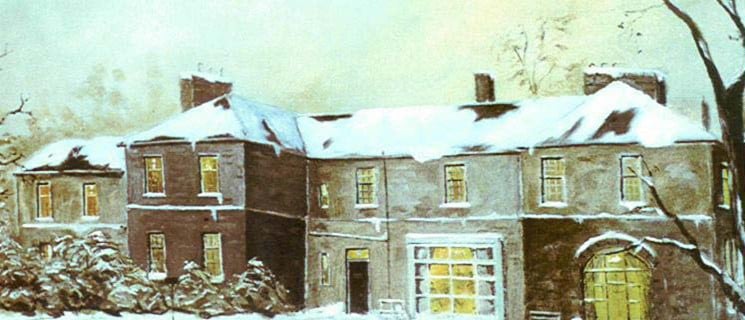

Parkhall House
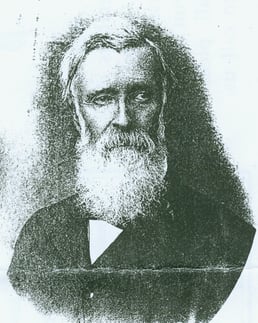

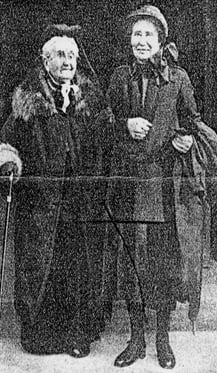

Thomas Livingstone-Learmonth
Mrs. Livingstone-Learmonth
and her sister
Mrs. Commisioner Booth-Tucker
(Minnie Reid)
The estate was eventually concecrated by Mr. and Mrs. Learmonth to the work and service of The Salvation Army. Army officers from the General downwards were entertained at Parkhall, Mrs. Learmonth adopted the Army uniform and even the childrens pinafores were decorated with the red 'S'. The house practically became an Army Training Home. Maddiston Corps was originally known as the Parkhall Brigade as the meetings were held in a barn at Parkhall.
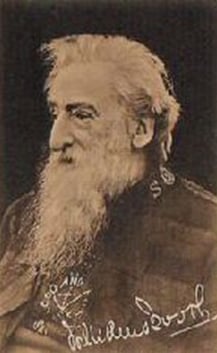

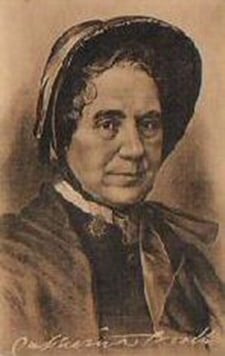

Founders of the Salvation Army, William and Catherine Booth